
Serbo-Croatian – also called Serbo-Croat, Serbo-Croat-Bosnian (SCB), Bosnian-Croatian-Serbian (BCS), and Bosnian-Croatian-Montenegrin-Serbian (BCMS) – is a South Slavic language and the primary language of Serbia, Croatia, Bosnia and Herzegovina, and Montenegro. It is a pluricentric language with four mutually intelligible standard varieties, namely Serbian, Croatian, Bosnian, and Montenegrin.
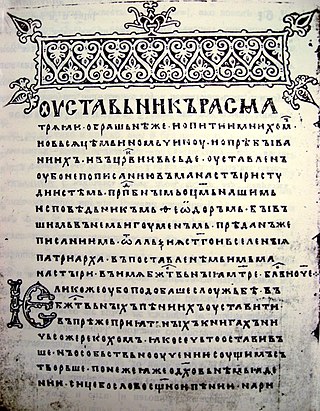
Old Church Slavonic or Old Slavonic is the first Slavic literary language.

Serbian is the standardized variety of the Serbo-Croatian language mainly used by Serbs. It is the official and national language of Serbia, one of the three official languages of Bosnia and Herzegovina and co-official in Montenegro and Kosovo. It is a recognized minority language in Croatia, North Macedonia, Romania, Hungary, Slovakia, and the Czech Republic.

Bosnian, sometimes referred to as Bosniak language, is the standardized variety of the Serbo-Croatian pluricentric language mainly used by ethnic Bosniaks. Bosnian is one of three such varieties considered official languages of Bosnia and Herzegovina, along with Croatian and Serbian. It is also an officially recognized minority language in Croatia, Serbia, Montenegro, North Macedonia and Kosovo.
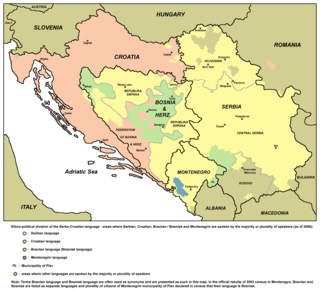
Standard Bosnian, Croatian, Montenegrin, and Serbian are different national variants and official registers of the pluricentric Serbo-Croatian language.
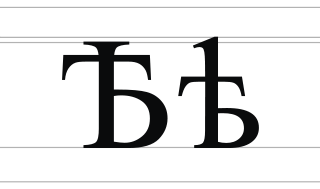
Yat or jat is the thirty-second letter of the old Cyrillic alphabet. It is usually romanized as E with a haček: Ě ě.
Montenegrin is a normative variety of the Serbo-Croatian language mainly used by Montenegrins and is the official language of Montenegro. Montenegrin is based on the most widespread dialect of Serbo-Croatian, Shtokavian, more specifically on Eastern Herzegovinian, which is also the basis of Standard Croatian, Serbian, and Bosnian.

The South Slavic languages are one of three branches of the Slavic languages. There are approximately 30 million speakers, mainly in the Balkans. These are separated geographically from speakers of the other two Slavic branches by a belt of German, Hungarian and Romanian speakers.

Gaj's Latin alphabet, also known as abeceda or gajica, is the form of the Latin script used for writing Serbo-Croatian and all of its standard varieties: Bosnian, Croatian, Montenegrin, and Serbian.
The orthography of the Macedonian language includes an alphabet consisting of 31 letters, which is an adaptation of the Cyrillic script, as well as language-specific conventions of spelling and punctuation.

The Illyrian movement was a pan-South-Slavic cultural and political campaign with roots in the early modern period, and revived by a group of young Croatian intellectuals during the first half of the 19th century, around the years of 1835–1863. This movement aimed to create a Croatian national establishment in Austria-Hungary through linguistic and ethnic unity, and through it lay the foundation for cultural and linguistic unification of all South Slavs under the revived umbrella term Illyrian.
The "National anthem of the Kingdom of Yugoslavia" was created in December 1918 from the national anthems of the Kingdom's three historical constituent lands: Kingdom of Croatia-Slavonia (Croatia), Kingdom of Serbia (Serbia) and Duchy of Carniola (Slovenia).

The Serbian Cyrillic alphabet is a variation of the Cyrillic script used to write the Serbian language, updated in 1818 by the Serbian philologist and linguist Vuk Karadžić. It is one of the two alphabets used to write modern standard Serbian, the other being Gaj's Latin alphabet.

The Novi Sad Agreement was a document composed by 25 Serbian, Croatian and Bosnian writers, linguists and intellectuals to build unity across the ethnic and linguistic divisions within Yugoslavia, and to create the Serbo-Croatian language standard to be used throughout the country.
Banat Bulgarian is the outermost dialect of the Bulgarian language with standardized writing and an old literary tradition. It is spoken by the Banat Bulgarians in the Banat region, in Romania and Serbia. Officially, it is spoken by 8,000 people, though other estimates give numbers up to 15,000.
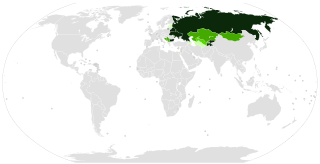
Numerous Cyrillic alphabets are based on the Cyrillic script. The early Cyrillic alphabet was developed in the 9th century AD and replaced the earlier Glagolitic script developed by the theologians Cyril and Methodius. It is the basis of alphabets used in various languages, past and present, Slavic origin, and non-Slavic languages influenced by Russian. As of 2011, around 252 million people in Eurasia use it as the official alphabet for their national languages. About half of them are in Russia. Cyrillic is one of the most-used writing systems in the world. The creator is Saint Clement of Ohrid from the Preslav literary school in the First Bulgarian Empire.
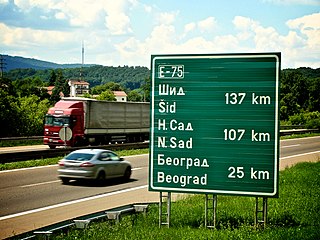
The romanization or Latinization of Serbian is the representation of the Serbian language using Latin letters. Serbian is written in two alphabets, Serbian Cyrillic, a variation of the Cyrillic alphabet, and Gaj's Latin, or latinica, a variation of the Latin alphabet. Both are widely used in Serbia. The Serbian language is thus an example of digraphia.
The Montenegrin alphabet is the collective name given to "Abeceda" and "Азбука", the writing systems used to write the Montenegrin language. It was adopted on 9 June 2009 by the Montenegrin Minister of Education, Sreten Škuletić and replaced the Serbian Cyrillic and Gaj's Latin alphabets in use at the time.

Croatian is the standardised variety of the Serbo-Croatian pluricentric language mainly used by Croats. It is the national official language and literary standard of Croatia, one of the official languages of Bosnia and Herzegovina, Montenegro, the Serbian province of Vojvodina, the European Union and a recognized minority language elsewhere in Serbia and other neighbouring countries.

The dialects of Serbo-Croatian include the vernacular forms and standardized sub-dialect forms of Serbo-Croatian as a whole or as part of its standard varieties: Bosnian, Croatian, Montenegrin, and Serbian. They are part of the dialect continuum of South Slavic languages that joins through the transitional Torlakian dialects the Macedonian dialects to the south, Bulgarian dialects to the southeast and Slovene dialects to the northwest.














